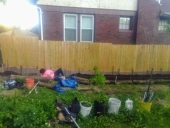Christian van der Stap wrote:Hello,
I will be building raised beds in my garden soon. The pathways will have a thick layer of would chips on top of old cobblestones.
The borders I want to create with the concrete tiles (hurts-your-back size) as they are already in the yard and chucking them would be a waste and expensive.
Using these will create a rather deep barrier, which might impede the moisture exchange between path and bed. I could put in a bit more effort
(which I really don't mind) and make sure that the tiles are shaped like a square arc such that the water can pass, which might flush the soil into the path.
Are there other things to consider? Currently I am leaning towards the square arc.
First off, I would not use the wood chips on top of cobblestones, this would be redundant and slow the breakdown process of the wood chips plus the cobbles will be easier on your feet, not harbor any diseases or insects like the wood chips will.
A better use of those wood chips would be as a mulch on the actual garden beds, some could even be mixed in with the soil should you desire that to help with air pockets for the microbiome of your garden soil.
For the borders I love your idea of reusing the tiles. I would lay out the bed, dig a trench to set the tiles in and then place them and pack the soil around to hold them in place. Most folks find a 1.5 m width just right for a bed to be worked from each side with no compaction by your feet.
No need to worry about moisture exchange, the whole idea of raised beds is to eliminate most of the moisture exchange you would see in a ground level garden bed.
Either of your designs will work well, the deciding factor should be planting space with easy working of the space the second factor, a third factor would be space drainage should you see water in the bed stand for over 1 hour.
Redhawk








